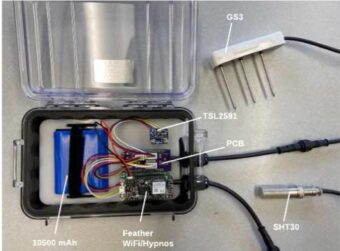
Imagine the sound of wind chimes. It’s pretty — but it’s more than that.
“The wind chime is a really interesting translation, and musicification or a sonification of an unseen environmental phenomenon,” said Oregon State University researcher Chet Udell. “It’s giving me information that could be useful if I’m curious about how windy it is outside. And it also is aesthetically pleasing.”
Udell’s lab unites engineers and environmental researchers to design environmental sensors. Wind chimes were the inspiration for one of the newest instruments, called WeatherChimes, which collects weather data and turns it into music. Now the technology will get used for projects across Southeast Alaska, starting in Sitka and Hoonah.
Scientists often express changes in the environment with things like graphs and charts — but what does that mean to a non-scientist?
“They show you the data and wiggles on a graph, but they don’t usually go too deep into having the person, like, translate that into meaning,” Udell said. “How do you get those people to empathize with environmental data?”

Udell and his team tried to build an environmental sensor that would be intuitive, emotional and creative. Like wind chimes, the WeatherChimes hardware is installed outside. It gathers data on things like light, temperature, humidity and soil moisture. Then it uses Wi-Fi to send that data into a program where it can be set to different keys, scales and instruments.
Humidity, for instance, could be a marimba playing a C major scale. By listening to those musical translations, you can hear weather patterns. Around sunrise and sunset, there’s a symphony of the world warming up and drying out. And throughout the day, there are melodies and countermelodies.
“There’s this thing in composition — Beethoven uses a lot, Bach uses a lot — called contrary motion,” Udell said. “Like, when one voice goes in one direction and another voice goes in a different direction.”
The WeatherChimes show the same thing happening in nature. Temperature and humidity, for instance, have an inverse relationship.
“And there’s a certain satisfaction in putting those kinds of natural things together, and seeing how patterns that exist naturally are the same ones that make this music fun,” Udell said.
Fun is one of the major goals. But as an educational tool, WeatherChimes could also help students think more deeply and personally about weather.
When there’s a particularly rainy period, is that good news or bad news? Udell hopes students can ponder questions like that through music.
“Should I make a happy melody or a sad melody? Should I make something that goes fast or slow?” he said. “Like, what does this mean to me?”
Educators at the Sitka Sound Science Center and Sitka High School’s Traditional Ecological Knowledge program will use WeatherChimes in classrooms and educational workshops over the coming year.
And Udell and his lab will work with the Sitka Sound Science Center, the Hoonah Indian Association and Alaska Youth Stewards to install more WeatherChimes for community-designed projects, including yellow cedar monitoring in Sitka and salmon stream monitoring in Hoonah.
